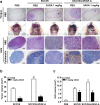3-O-Acetyloleanolic acid inhibits VEGF-A-induced lymphangiogenesis and lymph node metastasis in an oral cancer sentinel lymph node animal model
- PMID: 29976150
- PMCID: PMC6034267
- DOI: 10.1186/s12885-018-4630-0
3-O-Acetyloleanolic acid inhibits VEGF-A-induced lymphangiogenesis and lymph node metastasis in an oral cancer sentinel lymph node animal model
Abstract
Background: Sentinel lymph node metastasis is a common and early event in the metastatic process of head and neck squamous cell carcinoma (HNSCC) and is the most powerful prognostic factor for survival of HNSCC patients. 3-O-acetyloleanolic acid (3AOA), a pentacyclic triterpenoid compound isolated from seeds of Vigna sinensis K., has been reported to have potent anti-angiogenesis and anti-tumor activities. However, its effects on tumor-related lymphangiogenesis and lymph node metastasis are not yet understood.
Methods: The in vitro inhibitory effects of 3AOA on VEGF-A-induced lymphangiogenesis were investigated via in vitro experiments using mouse oral squamous cell carcinoma (SCCVII) cells and human lymphatic microvascular endothelial cells (HLMECs). The in vivo inhibitory effects of 3AOA on VEGF-A-induced lymphangiogenesis and sentinel lymph node metastasis were investigated in an oral cancer sentinel lymph node (OCSLN) animal model.
Results: 3AOA inhibited tumor-induced lymphangiogenesis and sentinel lymph node metastasis in an OCSLN animal model, and reduced expression of VEGF-A, a lymphangiogenic factor in hypoxia mimetic agent CoCl2-treated SCCVII cells. 3AOA inhibited proliferation, tube formation, and migration of VEGF-A-treated HLMECs. The lymphatic vessel formation that was stimulated in vivo in a by VEGF-A Matrigel plug was reduced by 3AOA. 3AOA suppressed phosphorylation of vascular endothelial growth factor (VEGFR) -1 and - 2 receptors that was stimulated by VEGF-A. In addition, 3AOA suppressed phosphorylation of the lymphangiogenesis-related downstream signaling factors PI3K, FAK, AKT, and ERK1/2. 3AOA inhibited tumor growth, tumor-induced lymphangiogenesis, and sentinel lymph node metastasis in a VEGF-A-induced OCSLN animal model that was established using VEGF-A overexpressing SCCVII cells.
Conclusion: 3AOA inhibits VEGF-A-induced lymphangiogenesis and sentinel lymph node metastasis both in vitro and in vivo. The anti-lymphangiogenic effects of 3AOA are probably mediated via suppression of VEGF-A/VEGFR-1 and VEGFR-2 signaling in HLMECs, and can be a useful anti-tumor agent to restrict the metastatic spread of oral cancer.
Keywords: 3-O-acetyloleanolic acid; Lymph node metastasis; Lymphangiogenesis; Oral cancer sentinel lymph node animal model; VEGF-A.
Conflict of interest statement
Ethics approval
This study (KHUASP-15-09) was reviewed and approved by the Institutional Animal Care and Use Committee of Kyung Hee University, and animal care and experimental procedures followed the University guidelines for the care and use of laboratory animals. The human cell line, HLMEC cells used in this study, were purchased from Lonza, and the use of widely available cell lines (Lonza, a publicly accessible repository) does not require ethical approval at our institution.
Consent for publication
Not applicable.
Competing interests
The authors declare that they have no competing interests.
Publisher’s Note
Springer Nature remains neutral with regard to jurisdictional claims in published maps and institutional affiliations.
Figures







Similar articles
-
Effects of 6,8-Diprenylgenistein on VEGF-A-Induced Lymphangiogenesis and Lymph Node Metastasis in an Oral Cancer Sentinel Lymph Node Animal Model.Int J Mol Sci. 2021 Jan 14;22(2):770. doi: 10.3390/ijms22020770. Int J Mol Sci. 2021. PMID: 33466636 Free PMC article.
-
3-O-Acetyloleanolic acid inhibits angiopoietin-1-induced angiogenesis and lymphangiogenesis via suppression of angiopoietin-1/Tie-2 signaling.Phytother Res. 2020 Feb;34(2):359-367. doi: 10.1002/ptr.6526. Epub 2019 Nov 3. Phytother Res. 2020. PMID: 31680342
-
Recombinant canstatin inhibits VEGF-A-induced lymphangiogenesis and metastasis in an oral squamous cell carcinoma SCC-VII animal model.Cancer Med. 2016 Oct;5(10):2977-2988. doi: 10.1002/cam4.866. Epub 2016 Sep 20. Cancer Med. 2016. PMID: 27650585 Free PMC article.
-
Pathways targeting tumor lymphangiogenesis.Clin Cancer Res. 2006 Dec 1;12(23):6865-8. doi: 10.1158/1078-0432.CCR-06-1800. Clin Cancer Res. 2006. PMID: 17145802 Review.
-
Tumor and lymph node lymphangiogenesis--impact on cancer metastasis.J Leukoc Biol. 2006 Oct;80(4):691-6. doi: 10.1189/jlb.1105653. Epub 2006 Jun 22. J Leukoc Biol. 2006. PMID: 16793912 Review.
Cited by
-
On the Value of In Vitro Cell Systems for Mechanobiology from the Perspective of Yes-Associated Protein/Transcriptional Co-Activator with a PDZ-Binding Motif and Focal Adhesion Kinase and Their Involvement in Wound Healing, Cancer, Aging, and Senescence.Int J Mol Sci. 2023 Aug 11;24(16):12677. doi: 10.3390/ijms241612677. Int J Mol Sci. 2023. PMID: 37628858 Free PMC article. Review.
-
The Role of Bioactive Compounds in Natural Products Extracted from Plants in Cancer Treatment and Their Mechanisms Related to Anticancer Effects.Oxid Med Cell Longev. 2022 Feb 15;2022:1429869. doi: 10.1155/2022/1429869. eCollection 2022. Oxid Med Cell Longev. 2022. PMID: 35211240 Free PMC article. Review.
-
The Chemokine CCL4 Stimulates Angiopoietin-2 Expression and Angiogenesis via the MEK/ERK/STAT3 Pathway in Oral Squamous Cell Carcinoma.Biomedicines. 2022 Jul 6;10(7):1612. doi: 10.3390/biomedicines10071612. Biomedicines. 2022. PMID: 35884919 Free PMC article.
-
The Regulation of Lymph Node Pre-Metastatic Niche Formation in Head and Neck Squamous Cell Carcinoma.Front Oncol. 2022 Apr 27;12:852611. doi: 10.3389/fonc.2022.852611. eCollection 2022. Front Oncol. 2022. PMID: 35574333 Free PMC article. Review.
-
Phytochemicals Targeting VEGF and VEGF-Related Multifactors as Anticancer Therapy.J Clin Med. 2019 Mar 12;8(3):350. doi: 10.3390/jcm8030350. J Clin Med. 2019. PMID: 30871059 Free PMC article. Review.
References
-
- Baek CH. Sentinel lymph node biopsy in the oral cavity cancer. Hanyang Med Rev. 2009;29(3):255–264. doi: 10.7599/hmr.2009.29.3.255. - DOI
MeSH terms
Substances
Grants and funding
LinkOut - more resources
Full Text Sources
Other Literature Sources
Medical
Miscellaneous

